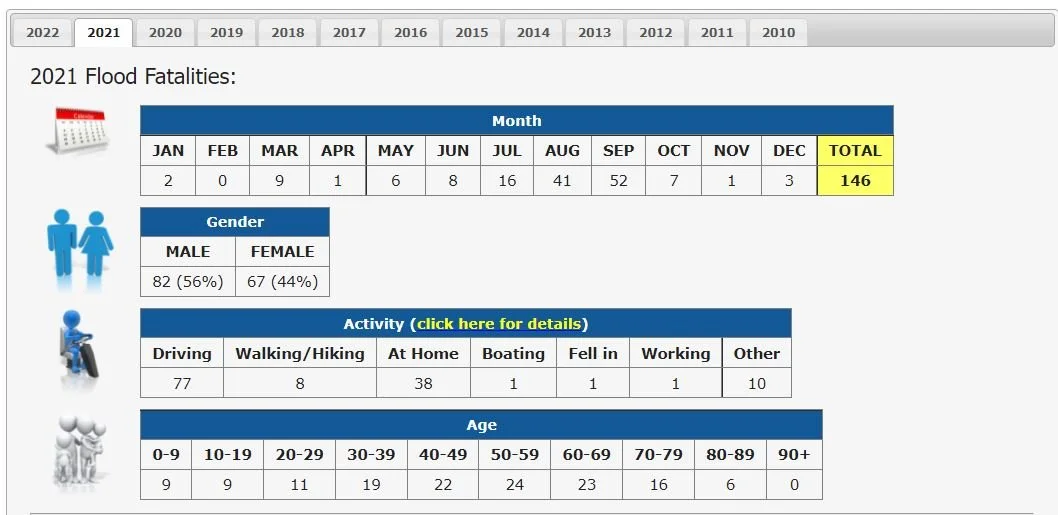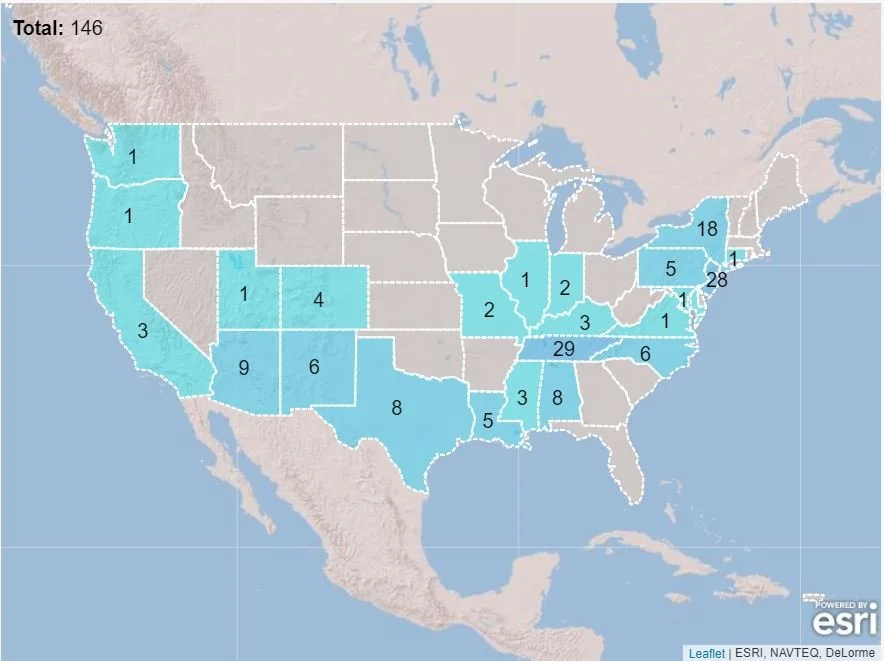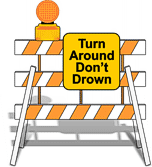Severe Weather Awareness - Flooding Safety
If you missed the first two articles we have written in this series about Severe Weather Awareness, you can check them out at the following links!
Tornado Safety | Lightning Safety
The third weather phenomenon we would like to talk about is flooding which is the leading cause of death in natural disasters in the United States except for heat-related fatalities. In fact, according to the National Oceanic and Atmospheric Administration (NOAA), the national 30-year average for flood deaths is 88. Comparing that to the 30-year average for deaths by lightning which is 41, tornadoes are 68, and hurricanes are 45. Of those, nearly half of all fatalities were caused by people in vehicles during flash flooding.
How many casualties occur from flooding varies year to year depending on the weather patterns, but if we look at the preliminary data available from 2021 from the media and National Weather Service (NWS) below, we can see that in total, 146 lives were lost due to flooding. 77 of those were from people in vehicles and 38 of those were people at home. 56% of those casualties were male.


Turn Around Don’t Drown
Most, if not all, flood-related deaths and injuries can be completely avoided if the general public would listen to this simple advice, “Turn Around Don’t Drown.” Oftentimes, people misjudge how powerful water is and by that point, it is too late.
All it takes is 6 inches of fast-moving water to knock the average adult off his or her feet and sweep them away. For a small car, all it takes is 12 inches of water, and for a large vehicle like a truck, van, or SUV, 18 to 24 inches of water. It can also be very hard to judge how deep the water actually is or if there is a road still there. Numerous times someone has driven through floodwaters and the road has been washed out and their vehicle is then swept away. Additionally, you want to stay off any bridges, dams, or man-made berms as fast-moving water can easily wash away these structures without warning.
It is not only your life you are putting at risk when you choose to drive through floodwaters but also any emergency personnel who then have to go and rescue you.
The Hidden Dangers of Flood Waters
There are also several hidden dangers that come with floodwaters that you need to also watch out for. One of these hidden dangers is electrocution. You never know if there is an exposed or downed power line in the floodwaters, so avoid wading, walking, or swimming in floodwaters if possible. You also want to avoid being in floodwaters in general if you do not have to be because you do not know what contaminants could be in the water. Some common contaminants found in floodwaters include human and livestock waste, household, medical, and industrial waste which could contain chemical, biological, and radiological agents. There can also be wild or stray animals within the floodwaters including rodents and snakes. You also do not know what is under that water, including debris, trees, rocks, sharp objects that could have been moved in the surging water, and all similar hazards that could be hidden and threaten to injure you or cause you to become stuck.
Exposure to any of these things can cause infections to open wounds, illness, rash, tetanus, and other possibly deadly illness or disease. If you do become exposed to floodwaters, it is very important to wash any and all areas that were exposed with soap and water, an alcohol-based wipe, or sanitizer. If you have an open wound that was exposed or received an open wound while being in floodwaters, clean and take care of the wound, then seek medical attention if necessary. Continue to monitor the wound for infection over the next several days. Any clothes that might have become contaminated by the floodwaters or sewage need to be washed in hot water with detergent.
There are additional risks to your building or home that can occur following a flooding event, we will touch on those more in-depth in a later section.
Make a Plan
Do you know the risk of flooding in your area? If your answer was no, use the FEMA Flood Map to enter your address and look at the risk in your area. After you have assessed the risk in your area, make a plan for yourself and your family, and don’t forget about your pets. Included in your plan should be multiple ways to receive alerts including what to do if power were to be lost. While making your plan, it is helpful to document with photos and video the important and valuable items in your home or business and store them in a safe place as they will be important to have if you are needing to file an insurance claim. Your plan should include routes for evacuation to higher ground, and possible areas to take shelter.
If there is a threat of flooding forecast or imminent for your area, prep ahead of time. Clean out your gutters and downspouts. Elevate or move important electrics off of the floor. Move furniture to the highest floor or attic if possible.
After Flooding
Following a flooding event it is important to get the home or building dried out and cleaned quickly, usually recommend to try and do this within 24 to 48 hours if possible to prevent mold growth. Before entering the home or building, it is very important to wear an N95 mask, just in case mold has started to develop. Open all windows and doors and use fans if possible with the fans pointing to blow the area out of the building or residence. All surfaces that were wet, need to be cleaned with soap and water and left to dry.
If you were not able to return to your home inside the 48-hour mark, because it was unsafe and officials wouldn’t allow you to, you will likely need to remove all porous, non-cleanable items from your home that got wet as they can be a source of mold growth if not removed. Some of those items include carpeting, clothes, leather, paper, wood, food, carpet padding, upholstery, wallpaper, drywall, floor, and ceiling tiles, and insulation.
For more information on how to deal with mold and moisture in your home, please reference the following guide from the Environmental Production Agency (EPA) A Brief Guide to Mold, Moisture, and Your Home.
What is a Flash Flood Warning, Flood Warning, Flood Watch, and Flood Advisory?
Flash Flood Warning: Take Action! If a Flash Flood Warning is issued when a flash flood is imminent or occurring. If you are in a flood-prone area, you need to move immediately to high ground.
A flash flood is a sudden violent flood that can take from minutes to hours to develop. It is even possible to experience a flash flood in areas not immediately receiving rain.
As of 2019, Flash Flood Warnings become Impact-Based Warnings which means they will automatically trigger a warning to your wireless phone or weather radio. In addition, these warnings will also be given a “Tag” that describes how damaging the threat could be, the source of the warning, and what caused the source to trigger the warning.
Flood Warning: Take Action! A Flood Warning is issued when a hazardous weather event is imminent or already happening. A Flood Warning is issued when flooding is imminent or occurring.
Flood Watch: Be Prepared: A Flood Watch is issued when conditions are favorable for a specific hazardous weather event to occur. A Flood Watch is issued when conditions are favorable for flooding. It does not mean flooding will occur, but it is possible.
Flood Advisory: Be Aware: An Flood Advisory is issued when a specific weather event that is forecast to occur may become a nuisance. A Flood Advisory is issued when flooding is not expected to be bad enough to issue a warning. However, it may cause significant inconvenience, and if caution is not exercised, it could lead to situations that may threaten life and/or property.
We hope this information was educational and provided you with a little more awareness when it comes to flood safety. While we hope no one has to ever experience such an event if any were to, we hope this material will help you or a loved one prepare and hopefully help guide you in the right direction to recover from such an event.
Sources
https://www.weather.gov/jetstream/flood#:~:text=While%20the%20number%20of%20fatalities,for%20flood%20deaths%20is%2088.
https://www.weather.gov/arx/usflood
https://www.cdc.gov/healthywater/emergency/extreme-weather/floods-standingwater.html
https://www.weather.gov/safety/flood-watch-warning
https://www.weather.gov/media/wrn/FFW-IBW-factsheet.pdf
https://www.cdc.gov/healthywater/emergency/extreme-weather/building-damage.html


